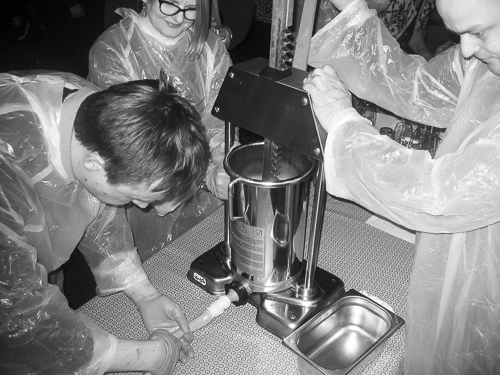About 25 persons went to a sausage course arranged by Indre Oslo matforedling at Vippa, a host of multiple food stands, located at Vippetangen in Oslo. We were met by Magnus Thorvik, one of the founders and owners of Indre Oslo Matforedling (IOm)
After having washed hands and being divided into groups of 5 people each, each group got a crate containing 5 kg of ground and very cold meat, which should be turned into sausages. First, we had to select which type of spice we wanted to use, next we added unrefined sea salt, amounting to 18g per kg of meat, together with paprika, common sage, chili and garlic which was crushed by means of a mortar and pestle. A list of our ingredients:
- 5 kg meat
- 90 g salt
- 50 g paprika
- Common sage
- 5.6 g chili
- 3 cloves of garlic in some red wine
The meat was from the farm of Heinrich Jung, a German farmer who has bought a farm in Norway. All the sows and piglets are free to go wherever they want as long as they stay within electrical fences and they stay outside all year, but they can enter metal sheds if they want. The farmer has to put dry straw on the ground of the sheds, else the sows take care of everything. As I was told at Virgenes farm, the pigs enter the sheds when the temperature is below -15°C(!). Instead, they don’t manage heat well, meaning they need shade and being able to roll in mud in summer.
As is stated on the web site of IOm, they stay in touch with the farmer and they visit the pigs as often as they can. The sows, whose bodies are destined for IOm, are allowed to live longer than most sows and also to weigh more, up to 350 kg(!). They are brought to the slaughterhouse separately where they will have their own rooms in order to let them be as relaxed as possible at the time of death. Not only because of animal welfare, but also because of less stress hormones and lactic acid in the meat. In addition, the meat tastes better. The meat is especially suited to both curing and making sausages, which is ideal for IOm.
Our next task was to knead the meat until it had the right consistency, which could be confirmed by forming a small bun of meat in your hand and holding the hand with the palm facing down. If it didn’t fall down, it was ready. A more nuanced test was to feel the meat manually and see that threads were formed and that the meat hung together like a uniform mass. IOm emphasises that the meat has to be kept cold during grinding and kneading such that the fat doesn’t melt, else the fat can be mixed with the meat particles such that they don’t join together.
The next step was to put all the meat in a sausage stuffer, which is a machine for stuffing ground meat into casings, and slip a hog casing onto the stuffing tube. While someone was turning a crank, which was compressing the meat, another one was holding the casing such that it was kept firm when meat starting flowing out of the stuffing tube and into the casing. We had to limit the speed of turning the crank, else the meat flowed out too quickly such that the casing broke. When a section of the casing was full of meat, one of us cut off the casing and closed it by means of a knot. Finally, Magnus showed us how to divide the long sausage into many small ones by pinching the casing and rotating it, forming joints about every 10 cm. Being beginners, the casing broke several times such that the above process had to be repeated some times.
Finally, when all the groups had finished making sausages, they were brought to the kitchen of Vippa where a cook fried all the sausages and prepared vegetables as well. Next, we gathered around some tables where we got to eat the sausages and the vegetables together with wine from NON DOS, a company which imports what they call naked wines. A perfect finish of a great course! As if that wasn’t enough, we also got about 1kg of our own sausages to bring home.
For those who want to make their own sausages, there is a very good explanation here.

